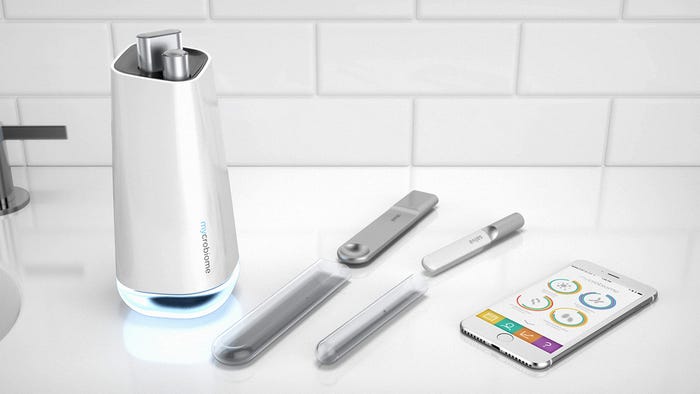MycrobiomeHow does the device work?
October 17, 2016
Mycrobiome |
|
How does the device work? The Mycrobiome is placed in the bathroom, plugged into the wall, and automatically connects to the Mycro Cloud via Wi-Fi or cellular network. Using disposable sample sticks, the user acquires small samples of both stool and saliva, inserts them into a clear cartridge to prevent cross contamination, and places them into the base unit. The samples are interrogated using fluorescence spectroscopy to rapidly detect, identify, and enumerate the microbiota. The device uploads and cross-references the user's microbiota with the NIH's microbial genome library, highlighting any differences. The Mycrobiome generates a personalized diet plan, helping balance and improve the user's microbiome. What healthcare problem does it solve? The Mycrobiome, and the information it provides, has the ability to impact several of the most pressing health issues of our time. Numerous studies are beginning to find significant associations between gut microbiomes and diseases such as obesity, diabetes, cancer, mental health, and autism. According to the NIH, understanding the individual's microbiome will "not only identify new ways to determine health and predisposition to diseases, but also define the parameters needed to design, implement and monitor strategies for intentionally manipulating the human microbiota to optimize its performance in the context of an individual's physiology" Why should the device be commercialized? The Mycrobiome should be commercialized to reduce the cost of healthcare by advancing the field of personalized medicine. Traditional medicine requires the onset of disease before it can treat, and treatment is based on broad populations and statistical averages of success. The healthcare industry must understand each person has a unique clinical, genetic, and genomic makeup, and the course of action to treat a disease should be as individualized as the person themselves. Building on the quantified self-movement, Mycrobiome empowers individuals to take control of their healthcare by translating complex genome sequences into simple, individual actions to improve their health. What inspired you to design this device? We asked staff to share stories of current healthcare problems they or their loved ones are facing. There was a common theme of ailments related to digestive health, a frustration with the difficulty to get an accurate diagnosis, and limited treatment options beyond pharmaceutical intervention. Initial research highlighted the NIH's Human Microbiome Project to sequence the human microbial genome and the global market for probiotics surpassing $35 Billion in 2015. This inspired the team to develop a simple way to quantify an individual's microbiota, leverage the expanding body of clinical data, and provide alternatives to conventional treatment methods. Submitted by: Reade Harpham |
You May Also Like





